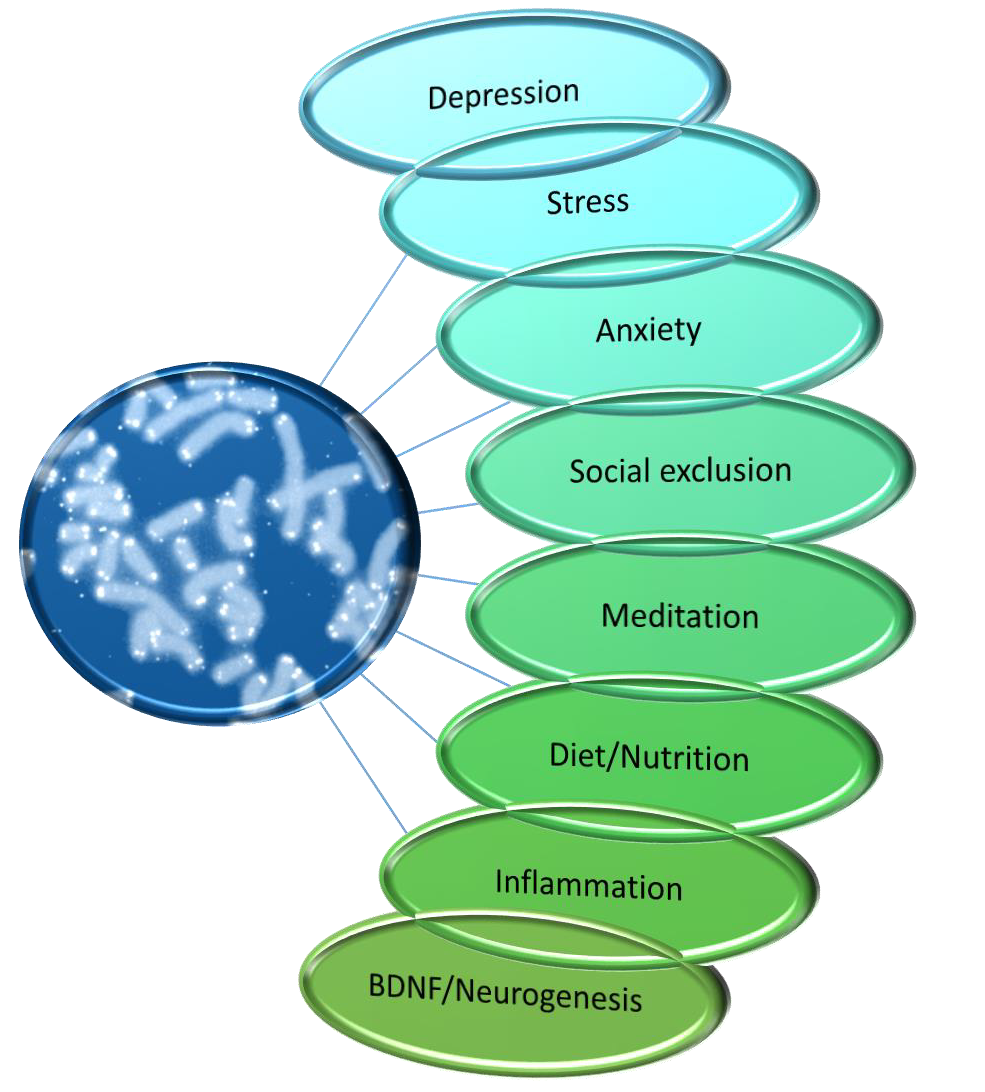
Telomere image source:
U.S. Department of Energy Genomic Science program
Created by Christopher B. Germann
http://cognovo.net/christopher-germann/

(O-phosphoryl-4-hydroxy-N,N-dimethyltryptamine)
Medical Hypotheses, 134, 1–9.


UCTV [ID: 23204] [Recorded on 11/10/2011] [Health and Medicine]
URL:
- Carhart-Harris, R. L., Roseman, L., Bolstridge, M., Demetriou, L., Pannekoek, J. N., Wall, M. B., … Nutt, D. J. (2017). Psilocybin for treatment-resistant depression: fMRI-measured brain mechanisms. Scientific Reports, 7(1), 13187. https://doi.org/10.1038/s41598-017-13282-7
- Catlow, B. J., Song, S., Paredes, D. A., Kirstein, C. L., & Sanchez-Ramos, J. (2013). Effects of psilocybin on hippocampal neurogenesis and extinction of trace fear conditioning. Experimental Brain Research, 228(4), 481–491. https://doi.org/10.1007/s00221-013-3579-0
- Epel, E., Daubenmier, J., Moskowitz, J. T., Folkman, S., & Blackburn, E. (2009). Can Meditation Slow Rate of Cellular Aging? Cognitive Stress, Mindfulness, and Telomeres. Annals of the New York Academy of Sciences, 1172(1), 34–53. https://doi.org/10.1111/j.1749-6632.2009.04414.x
- Gotlib, I. H., LeMoult, J., Colich, N. L., Foland-Ross, L. C., Hallmayer, J., Joormann, J., … Wolkowitz, O. M. (2015). Telomere length and cortisol reactivity in children of depressed mothers. Molecular Psychiatry, 20(5), 615–620. https://doi.org/10.1038/mp.2014.119
- Griffiths, R. R., Richards, W. A., McCann, U., & Jesse, R. (2006). Psilocybin can occasion mystical-type experiences having substantial and sustained personal meaning and spiritual significance. Psychopharmacology, 187(3), 268–283. https://doi.org/10.1007/s00213-006-0457-5
- Hoge, E. A., Chen, M. M., Orr, E., Metcalf, C. A., Fischer, L. E., Pollack, M. H., … Simon, N. M. (2013). Loving-Kindness Meditation practice associated with longer telomeres in women. Brain, Behavior, and Immunity, 32, 159–163. https://doi.org/10.1016/j.bbi.2013.04.005
- Johnson, M. W., & Griffiths, R. R. (2017). Potential Therapeutic Effects of Psilocybin. Neurotherapeutics, 14(3), 734–740. https://doi.org/10.1007/s13311-017-0542-y
- Kraehenmann, R., Schmidt, A., Friston, K., Preller, K. H., Seifritz, E., & Vollenweider, F. X. (2016). The mixed serotonin receptor agonist psilocybin reduces threat-induced modulation of amygdala connectivity. NeuroImage: Clinical, 11, 53–60. https://doi.org/10.1016/j.nicl.2015.08.009
- Malan, S., Hemmings, S., Kidd, M., Martin, L., & Seedat, S. (2011). Investigation of telomere length and psychological stress in rape victims. Depression and Anxiety, 28(12), 1081–1085. https://doi.org/10.1002/da.20903
- McCorvy, J. D., Olsen, R. H., & Roth, B. L. (2016). Psilocybin for depression and anxiety associated with life-threatening illnesses. Journal of Psychopharmacology, 30(12), 1209–1210. https://doi.org/10.1177/0269881116675771
- Preller, K. H., Pokorny, T., Krähenmann, R., Dziobek, I., Stämpfli, P., & Vollenweider, F. X. (2015). The Effect of 5-HT2A/1a Agonist Treatment On Social Cognition, Empathy, and Social Decision-making. European Psychiatry, 30, 22. https://doi.org/10.1016/S0924-9338(15)30017-1
- Roseman, L., Demetriou, L., Wall, M. B., Nutt, D. J., & Carhart-Harris, R. L. (2018). Increased amygdala responses to emotional faces after psilocybin for treatment-resistant depression. Neuropharmacology, 142, 263–269. https://doi.org/10.1016/j.neuropharm.2017.12.041
- Ross, S., Bossis, A., Guss, J., Agin-Liebes, G., Malone, T., Cohen, B., … Schmidt, B. L. (2016). Rapid and sustained symptom reduction following psilocybin treatment for anxiety and depression in patients with life-threatening cancer: a randomized controlled trial. Journal of Psychopharmacology, 30(12), 1165–1180. https://doi.org/10.1177/0269881116675512
- Wei, Y. Bin, Backlund, L., Wegener, G., Mathé, A. A., & Lavebratt, C. (2015). Telomerase dysregulation in the hippocampus of a rat model of depression: Normalization by lithium. International Journal of Neuropsychopharmacology. https://doi.org/10.1093/ijnp/pyv002
- Wikgren, M., Maripuu, M., Karlsson, T., Nordfjäll, K., Bergdahl, J., Hultdin, J., … Norrback, K.-F. (2012). Short Telomeres in Depression and the General Population Are Associated with a Hypocortisolemic State. Biological Psychiatry, 71(4), 294–300. https://doi.org/10.1016/j.biopsych.2011.09.015
- Wolkowitz, O. M., Mellon, S. H., Epel, E. S., Lin, J., Dhabhar, F. S., Su, Y., … Blackburn, E. H. (2011). Leukocyte Telomere Length in Major Depression: Correlations with Chronicity, Inflammation and Oxidative Stress - Preliminary Findings. PLoS ONE, 6(3), e17837. https://doi.org/10.1371/journal.pone.0017837
- Wolkowitz, O. M., Reus, V. I., & Mellon, S. H. (2011). Telomere shortening in leukocyte subpopulations in depression. Dialogues in Clinical Neuroscience, 13(1), 25–39. https://doi.org/10.1186/1471-244X-14-192
- Wolkowitz, O. M., Reus, V. I., & Mellon, S. H. (2011). Of sound mind and body: depression, disease, and accelerated aging. Dialogues in Clinical Neuroscience, 13(1), 25–39. Retrieved from http://www.ncbi.nlm.nih.gov/pubmed/21485744

“Those who have handled sciences have been either men of experiment or men of dogmas. The men of experiment are like the ant, they only collect and use; the reasoners resemble spiders, who make cobwebs out of their own substance. But the bee takes a middle course: it gathers its material from the flowers of the garden and of the field, but transforms and digests it by a power of its own. Not unlike this is the true business of philosophy; for it neither relies solely or chiefly on the powers of the mind, nor does it take the matter which it gathers from natural history and mechanical experiments and lay it up in the memory whole, as it finds it, but lays it up in the understanding altered and digested. Therefore from a closer and purer league between these two faculties, the experimental and the rational (such as has never yet been made), much may be hoped.”
Francis Bacon, Novum Oganum, Book I (1620)
A biological analogy by Sir Francis Bacon (Novum Organum, 1620)

